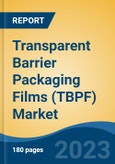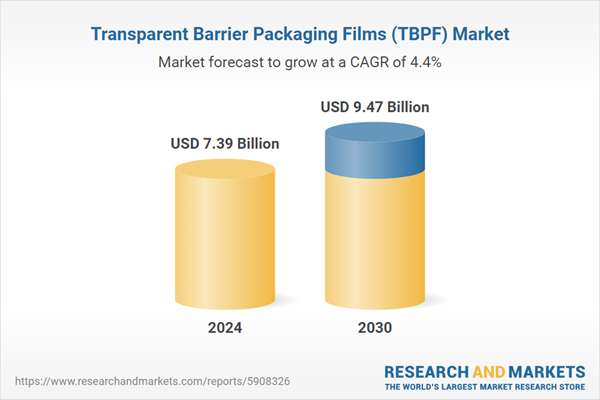Speak directly to the analyst to clarify any post sales queries you may have.
10% Free customizationThis report comes with 10% free customization, enabling you to add data that meets your specific business needs.
The increasing global demand for consumer-friendly and sustainable packaging solutions is a key growth driver for the market. Transparent barrier films are especially gaining traction in the food and beverage sector, where the shift toward convenience and ready-to-eat packaged foods is accelerating. As consumer lifestyles become more fast-paced, particularly in urban areas, the demand for lightweight, durable, and visually appealing packaging has risen substantially.
The pharmaceutical industry, especially in emerging economies is increasingly adopting these films to ensure safe, tamper-evident, and contamination-free packaging for medications and healthcare products.The rapid expansion of the e-commerce sector, particularly in Asia-Pacific and other emerging markets, is contributing to market growth. E-commerce requires packaging solutions that offer both product protection and aesthetic value, a demand well-met by transparent barrier packaging films. The increasing consumer awareness of hygiene, product safety, and environmental impact has also led to a shift in preference toward high-barrier, recyclable, and customized packaging solutions.
Key Market Drivers
Growing Demand of Transparent Barrier Packaging Films (TBPF) from Food & Beverage Industry
Transparent Barrier Packaging Films (TBPF) are advanced, lightweight materials designed to provide robust protection against oxygen, moisture, and external contaminants, thereby preserving product freshness and quality. Their high transparency also enables clear visibility of packaged contents, an essential marketing advantage in today’s visually driven consumer market. TBPF plays a vital role in extending shelf life and ensuring product safety, especially within the food and beverage industry, where preserving flavor, texture, and nutritional value is paramount. By minimizing spoilage and reducing food waste, TBPF supports more sustainable consumption patterns.As consumer lifestyles evolve toward convenience, demand has surged for ready-to-eat meals, health-oriented snacks, and on-the-go beverages, all requiring secure and efficient packaging. This trend has positioned TBPF as a preferred solution across the sector. The Global Transparent Barrier Packaging Films (TBPF) Market underscores the growing importance of effective food preservation solutions amid rising global food demand. Between 2010 and 2050, global food demand is projected to increase significantly by 35% to 56%. When accounting for the impacts of climate change, this estimate rises further to a range of 30% to 62%. This growing demand highlights the critical need for advanced packaging technologies, such as TBPF, which play a vital role in extending the shelf life and maintaining the quality of food products.
Simultaneously, the global population at risk of hunger is expected to vary between a decrease of 91% to an increase of 8% under baseline scenarios. However, with the effects of climate change factored in, this range could widen further, from a reduction of 91% up to a potential increase of 30%. These projections emphasize the urgency of minimizing food loss and waste, where TBPF’s protective barrier properties help reduce spoilage by safeguarding products from oxygen, moisture, and contaminants. The anticipated surge in food demand combined with the uncertainties brought by climate change reinforces the critical role of Transparent Barrier Packaging Films in supporting global food security. By enhancing product preservation and reducing waste, TBPF technologies are positioned as essential components in addressing the challenges of feeding a growing and climate-impacted global population.
Key Market Challenges
Complexities Associated with Recycling and Waste Management
Thin Barrier Plastic Films (TBPF) have gained significant traction due to their effectiveness in extending product shelf life, reducing food waste, and enhancing visual presentation. By forming a barrier against moisture, oxygen, and external contaminants, TBPF ensures product freshness and minimizes spoilage. These benefits also support sustainable packaging practices by reducing the need for additional packaging materials. Despite these advantages, TBPF presents notable environmental challenges, particularly related to disposal and recycling. Globally, only about 9% of plastic waste is recycled effectively, with the majority ending up in landfills, incinerators, or the natural environment.TBPF is especially difficult to recycle due to its multi-layered composition, which often includes different types of plastics combined with inks, adhesives, and coatings. These materials complicate the separation and purification processes required for effective recycling.The improper disposal of TBPF contributes significantly to environmental pollution, threatening wildlife and ecosystems, particularly in marine environments. As public concern over plastic pollution intensifies, industries face increasing pressure to adopt more sustainable waste management practices and reduce their environmental footprint.
To address these issues, investment in innovative recycling technologies is essential. Advanced processes that can efficiently handle multi-material films and remove contaminants are needed to improve TBPF recycling rates. At the same time, raising awareness among consumers about responsible usage and disposal is critical. Education and collaboration across the value chain - from manufacturers to end-users - can foster more sustainable consumption habits and support the transition to a circular plastic economy, reducing the long-term environmental impact of TBPF.
Key Market Trends
Advancement in Barrier Technologies
Transparent Barrier Packaging Films (TBPF) are lightweight, high-performance films that offer exceptional protection against oxygen, moisture, and other external contaminants. As consumer expectations rise and regulatory requirements become more stringent, the demand for advanced barrier technologies in packaging has accelerated significantly. One of the most impactful innovations in this space is the development of multi-layered films. These films combine multiple material layers, each engineered to provide specific functions such as moisture resistance, oxygen barrier, or UV protection. This multilayer structure allows for tailored packaging solutions that meet the unique preservation needs of various products, enhancing shelf life and maintaining quality across industries.In addition to multilayer films, nanotechnology integration has emerged as a key advancement. Nanotechnology enables the creation of films with superior barrier properties while reducing overall thickness and improving mechanical strength. This breakthrough not only optimizes material usage but also enhances packaging performance, enabling manufacturers to extend product freshness and reduce waste.
Sustainability is another critical driver of innovation in the TBPF market. Bio-based films, derived from renewable resources, are gaining traction as environmentally friendly alternatives to traditional petroleum-based films. These bio-based options deliver comparable barrier performance while aligning with increasing consumer and corporate commitments to sustainability and reduced environmental impact. These technological advancements have broadened the application scope of TBPF, allowing manufacturers to offer highly customized packaging solutions that address industry-specific challenges. The introduction of sustainable bio-based films resonates strongly with eco-conscious markets, further propelling growth in the TBPF sector.
Advancements in barrier technologies are reshaping the global Transparent Barrier Packaging Films market. By combining enhanced protection, customization, and sustainability, these innovations are set to drive the market forward, meeting evolving industry demands and contributing to a more sustainable packaging future.
Key Market Players
- 3M Co.
- Amcor Plc
- Berry Global Group Inc.
- CCL Industries Inc.
- Celplast Metallized Products Ltd
- Cosmo Films Ltd
- Dai Nippon Printing Co. Ltd.
- DUO PLAST AG
- DuPont de Nemours Inc.
- Jindal Poly Films Ltd.
Report Scope:
In this report, the Global Transparent Barrier Packaging Films (TBPF) Market has been segmented into the following categories, in addition to the industry trends which have also been detailed below:Transparent Barrier Packaging Films (TBPF) Market, By Type:
- Pouch Packaging
- Skin Packaging
- Windowed Packaging
Transparent Barrier Packaging Films (TBPF) Market, By End User:
- Consumer Goods
- Personal Care
- Others
Transparent Barrier Packaging Films (TBPF) Market, By Region:
- North America
- United States
- Canada
- Mexico
- Europe
- France
- United Kingdom
- Italy
- Germany
- Spain
- Asia-Pacific
- China
- India
- Japan
- Australia
- South Korea
- South America
- Brazil
- Argentina
- Colombia
- Middle East & Africa
- South Africa
- Saudi Arabia
- UAE
- Egypt
Competitive Landscape
Company Profiles: Detailed analysis of the major companies present in the Global Transparent Barrier Packaging Films (TBPF) Market.Available Customizations:
With the given market data, the publisher offers customizations according to a company's specific needs. The following customization options are available for the report.Company Information
- Detailed analysis and profiling of additional market players (up to five).
This product will be delivered within 1-3 business days.
Table of Contents
Companies Mentioned
- 3M Co.
- Amcor Plc
- Berry Global Group Inc.
- CCL Industries Inc.
- Celplast Metallized Products Ltd
- Cosmo Films Ltd
- Dai Nippon Printing Co. Ltd.
- DUO PLAST AG
- DuPont de Nemours Inc.
- Jindal Poly Films Ltd
Table Information
| Report Attribute | Details |
|---|---|
| No. of Pages | 185 |
| Published | August 2025 |
| Forecast Period | 2024 - 2030 |
| Estimated Market Value ( USD | $ 7.39 Billion |
| Forecasted Market Value ( USD | $ 9.47 Billion |
| Compound Annual Growth Rate | 4.3% |
| Regions Covered | Global |
| No. of Companies Mentioned | 10 |









